Using solar energy to heat water produces no harmful greenhouse gas emissions. A solar water heater can provide between 50 percent and 90 percent of your total hot water requirements, depending on the climate and the model of heater.
The upfront cost of a solar water heater (including installation) is higher than electric or gas water heaters but energy bill savings will compensate for this over time.
Government rebates are available in many parts of Australia to assist with the initial purchase cost of a solar water heater. How do they work?
Most solar hot water systems use solar collectors or panels to absorb energy from the sun. Water is heated by the sun as it passes through the collectors. It then flows into an insulated storage tank for later use.
In passive systems, water flows unassisted between the collectors and the tank. In active systems, water is pumped between the collectors and the tank.
The storage tank is usually fitted with an electric, gas or solid fuel booster that heats the water when sunlight is insufficient. Some solar water heaters also have frost protection to prevent damage in frost prone areas.
SOLAR COLLECTORS
Solar collectors trap and use heat from the sun to raise the temperature of water. Flat-plate solar collectors are the most common type. They are comprised of:
- An airtight box with a transparent cover.
- A dark coloured, metallic absorbing plate containing water pipes.
- Insulation to reduce heat loss from the back and sides of the absorber plate.
Properly maintained solar thermal collectors should outlast the life of the storage tank. When the tank needs replacing, the existing collectors can be connected to the new tank.
FROST PROTECTION
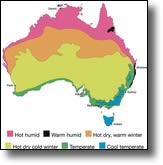
Frost protection for solar collectors is essential in frost prone areas. During a frost, water can freeze in the solar collector and damage it unless preventative measures are taken. Common types of frost protection include:
- Knock valves (mechanical drain down valves). These valves can be problematic as they often jam open and drain the tank, or fail to operate, causing severe damage.
- Electric heating elements, which are vulnerable in the event of power failure.
- Closed circuit systems, which separate the heating fluid from the water (see below). Closed circuit systems are usually the best option in frost prone areas as they ensure that water does not flow through the solar collectors.
OPEN CIRCUIT VS CLOSED CIRCUIT
In an open circuit system, water flows directly through the solar collectors, into the storage tank and then through pipes into your home.
In a closed circuit system a fluid other than water flows through the collectors, picks up heat from the sun, and transfers this heat to water in the storage tank through a heat exchanger.
Closed circuit systems are most commonly used for frost protection (see above). A fluid with a lower freezing point than water is used to avoid ice formation in the solar collectors. It is important to choose the fluid carefully as some become "gluggy" and reduce efficiency.
Some closed circuit systems pump hot water through the collectors when temperatures approach freezing. This lowers efficiency significantly. Avoid systems with this feature.
PASSIVE VS ACTIVE SYSTEM
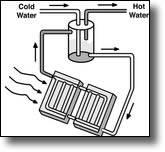
Passive systems
In Passive systems (or thermosiphon systems) the tank is placed above the solar collectors so that cold water sinks into the collectors, where it is warmed by the sun, and rises into the tank. A continuous flow of water through the collectors is created without the need for pumps.
Passive systems come in two types: closed-coupled or gravity feed.
In a close-coupled system the horizontal storage tank is mounted directly above the collector on the roof. Heated water is supplied at mains pressure. This arrangement is the most cost effective to install but efficiency is reduced in cool and cold climates by heat loss from the tank.
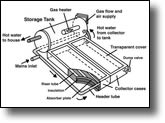
Additional insulation of tanks is desirable in these climates. Alternatively, tanks can be detached and moved inside the roof space.
In a gravity-feed system, the storage tank is installed in the roof cavity. These systems are cheapest to purchase but household plumbing must be suitable for gravity feeding, including larger diameter pipes between the water heater and the taps. A common alternative is to use a closed circuit gravity feed system to heat mains pressure water using a heat exchanger.

Active systems
In active systems (also known as pump systems or split systems), solar panels are installed on the roof and the storage tank is located on the ground or another convenient location, that does not have to be above the solar collectors. Water (or another fluid) is pumped through the solar collectors using a small electric pump.
Because active systems do not require a roof-mounted tank they have little visual impact, particularly when the solar collectors are mounted flush with the roof. However, active systems are usually more expensive to purchase and require more maintenance than passive systems.
Active systems use more energy than passive systems because extra energy is required to pump fluid around the system. There are also additional heat losses in the pipes between the tank and the solar collectors. However, if renewable energy is used to power the pump and a high level of insulation is used for the pipes and tank, active systems can reduce greenhouse gas emissions as much as a passive system.
[See: Energy Use Introduction]
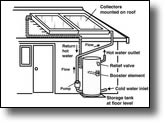
Active systems are often used for solar conversions, when solar collectors are added to an existing hot water system. They may also be used when the roof can't support a passive system.
Storage tanks
Tanks are manufactured from stainless steel, copper or mild steel coated with vitreous enamel.
Copper-lined tanks are only suitable for low-pressure systems. The other tanks are suitable for mains pressure.
Vitreous enamel tanks are fitted with a 'sacrificial anode' that needs to be replaced every five to seven years to protect against corrosion (more frequently where water quality is poor). Other tanks do not require this protection.
Outdoor storage tanks can suffer frost damage and significant heat losses in cool climates. In such climates they should be located indoors whenever possible, as part of a drying cupboard.
BOOSTER SYSTEMS
Solar water heaters can be gas, electric or solid fuel boosted.
Electric boosters use an electric element inside the storage tank to heat water.
Gas boosters use a natural gas burner to heat water either in the storage tank or as a separate unit downstream from the storage tank.
Solid fuel boosters heat water through a heat exchanger, commonly known as a "wet back" system.
Gas and solid fuel boosted systems produce less greenhouse gas emissions.
[See: Hot Water Service]
Boosters can be manually operated or automatically controlled by a thermostat that cuts in when tank temperatures fall below desired levels. If boosters are not appropriately designed and operated they can defeat the purpose of having a solar water heater by reducing the solar contribution.
For example, thermostat controlled boosters often cut in at night, which means that when the sun rises, there is little useful heating to be done.
In well designed solar water heaters the booster heating element will be positioned to maximise solar contribution. Hot water enters the tank at the bottom, so the element should be high up in the tank to avoid interference with hot water coming in. However, if it is too high in the tank it will not be able to heat enough water on cloudy days.
Timers can also be used to manage boosters and ensure that you get the maximum solar contribution. Talk to your supplier about correct operation of timers.
Another solution is to turn off your booster and fit a separate instantaneous water heater between the outlet line from the solar system and your taps. This is a very expensive option and not all instantaneous units are suitable for this application. However this combination will use only sufficient gas or electricity to heat (or top up) water on an "as needed" basis and will allow maximum use of the sun's free energy. It can be economical for apartment blocks.
SOLAR BOOSTED HEAT PUMPS
Heat pumps work like a refrigerator in reverse, absorbing heat from the air and transferring it to the water. [See: Hot Water Service]
Solar boosted heat pumps use solar collectors to further improve the efficiency of a heat pump system. They are active closed circuit systems that use a refrigerant as the heat transfer fluid and do not require frost protection. Heat pumps work even when the sun is not shining, as the refrigerant can absorb heat from the ambient air.
Although heat pumps use electricity, they are very efficient and can operate 24 hours a day without a booster. They also require a smaller storage tank than other solar hot water systems.
In the cool climates of southern Australia, greenhouse gas emissions from solar boosted heat pump systems can be similar to or less than those from a solar water heater with an electric booster. However, in most parts of Australia a solar water heater with an electric booster will have fewer greenhouse gas emissions than a heat pump system.
CHOOSING A SOLAR WATER HEATER
For general information on choosing a water heater, see the Hot Water Service fact sheet, which provides a comparison of water heaters (including solar water heaters) in terms of greenhouse gas emissions and costs.
[See: Hot Water Service]
Seek expert advice before deciding which solar water heater to buy.
Climate considerations are very important when selecting a solar water heater and your state government advisory centres can provide excellent local advice. State governments can also provide advice on any rebates that are available in your area. For a list of contacts
[See: Energy Use Introduction]
The Australian Consumers' Association provides detailed information to help you choose the best solar water heater for your location and budget.
Manufacturers and retailers may also be able to help with detailed selection guidelines.
CHOOSING THE RIGHT SIZE
The best size of storage tanks and solar panels depends on the number of people in the home, how efficiently they use water, the climate and the efficiency of the water heater.
Reducing your hot water demand can reduce the size and cost of the system you need.
[See: Hot Water Service; Reducing Water Demand]
Manufacturers or suppliers will advise the best size for your application.
POSITIONING YOUR SOLAR WATER HEATER
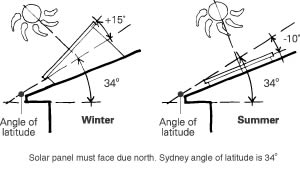 For optimum performance throughout Australia solar hot water systems should face solar north. Orientation can deviate up to 45° from north without significant loss of efficiency. Use a compass to check orientation.
For optimum performance throughout Australia solar hot water systems should face solar north. Orientation can deviate up to 45° from north without significant loss of efficiency. Use a compass to check orientation.
[See: Orientation]
For maximum efficiency, ensure that the solar collectors are not shaded by trees or nearby buildings, particularly in winter when the sun is low in the sky.
For best performance, solar collectors need to be installed at an angle to the horizontal. This maximises the amount of sunlight falling on the panels. For maximum winter performance, panels should be installed at an angle 5° to 10° greater than the angle of latitude at the site. The ideal angle increases from 17.5° to the horizontal in Darwin to 53° to the horizontal in Hobart.
Roof pitch angles in Australia are commonly between 20° and 30°. It is cheaper and usually more aesthetically pleasing to install solar collectors flush with the roof, rather than use supports to achieve a greater angle. Performance in winter may be slightly reduced, but the benefits usually outweigh the costs.
OTHER INSTALLATION TIPS
A complete thermosiphon system, when full of water, can weigh several hundred kilograms. Most roofs can support a storage tank without reinforcement but you need to check this before installation. Talk to your builder, designer or engineer to find out.
Be sure to insulate all components, including pipes, to get the best performance from your system. This is particularly important for thermosiphon systems where there is a long distance between the tank and the hot water taps. It is critical in cold climates.
Make sure the booster control is in an accessible location and has an indicator light you can see from inside to remind you to turn it off when not required.
OPERATING AND MAINTAINING YOUR SYSTEM
Follow the manufacturer's maintenance recommendations.
Set the temperature of your booster thermostat to about
600C. A lower setting will use less energy but you should stay above 550 to prevent growth of harmful bacteria.
In favourable climates during summer, water temperatures in a solar water heater can approach boiling point. Heat dissipation devices may be required to prevent water from boiling. It may also be necessary to fit a mixing valve to reduce water temperatures experienced at the tap to safe levels during summer.
Carry out jobs that need hot water early in the day so that the water left in the tank will be reheated by the sun, ready for use at night.
Regularly clean solar panels to remove dust. You can use a broom with some detergent to give them a scrub.
Flush out collectors to remove sludge. Heat pump systems do not require flushing.
Make sure you turn the booster off when going on holidays and consider turning it off during summer if conditions are favourable.



![A Tranquil Jungle House That Incorporates Japanese Ethos [Video]](https://asean2.ainewslabs.com/images/22/08/b-2ennetkmmnn_t.jpg)









